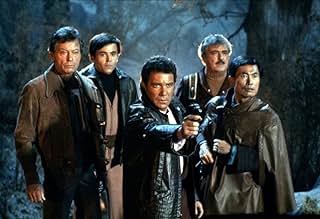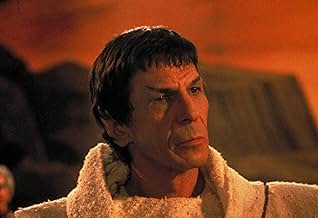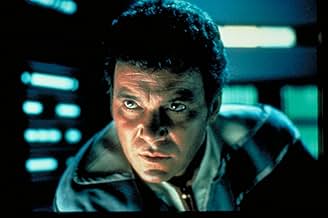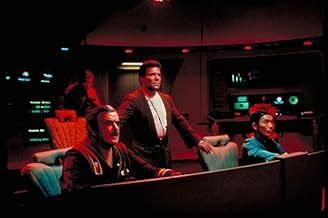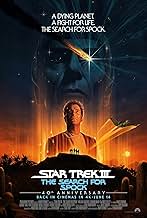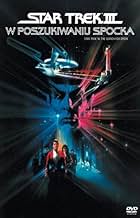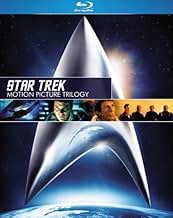Star Trek III : À la recherche de Spock
Titre original : Star Trek III: The Search for Spock
- 1984
- Tous publics
- 1h 45min
NOTE IMDb
6,7/10
89 k
MA NOTE
L'amiral Kirk et son équipe risquent leur carrière en volant l'USS Enterprise, désarmé, afin de retourner sur la planète Genesis, en quarantaine, pour récupérer le corps de Spock.L'amiral Kirk et son équipe risquent leur carrière en volant l'USS Enterprise, désarmé, afin de retourner sur la planète Genesis, en quarantaine, pour récupérer le corps de Spock.L'amiral Kirk et son équipe risquent leur carrière en volant l'USS Enterprise, désarmé, afin de retourner sur la planète Genesis, en quarantaine, pour récupérer le corps de Spock.
- Réalisation
- Scénario
- Casting principal
- Récompenses
- 1 victoire et 10 nominations au total
Leonard Nimoy
- Spock
- (as Frank Force)
- …
Avis à la une
How does one follow a film with a fantastic villain, perfect structure, and really good special effects? Muddy the waters, apparently.
Don't get me wrong. I feel like the third Star Trek film is good, but it's also got problems.
So, let's start with the good. The Enterprise is coming home from the Mutara system, wounded with one less officer. There's no sense of victory as the ship tracks into spacedock where its wounds get pushed into a harsh light. Captain Kirk dismisses a cadet's desire for a celebration by referring to paying for their return with their dearest blood. And, on top of it, McCoy is acting odd. He breaks into Spock's sealed quarters and talks of a need to go to Vulcan. Spock's father, the Vulcan ambassador Sarek, tells Kirk of the need to bring Spock's katra, his soul, back to Vulcan, or his essence will die forever.
Kirk must get Spock's body back from the Genesis planet where they shot his body, but Starfleet won't allow it. The Genesis planet is at the center of a galactic controversy and has been declared forbidden.
All of this first act up to this point is a bit clunkier than it should be, but it's effective at getting the point across. And then we get to one of my two favorite individual sequences in all of the Star Trek movies (both of which are in this one, actually).
There are a few things in the sequence of the Enterprise escaping Space Dock that get me. First is the music. James Horner did a bang up job for the previous film, and Nimoy, the director, brought him back to score this. Here, Horner explores the musical themes he created in the second film and gives them greater scope and a larger breadth. The second is the action itself. Much like in the second film, there's an understanding of the limitations of what the models can do, and turning a slow chase out of a dock into something really exciting through the editing is a solid accomplishment. The third is about Kirk. Kirk knows that what he's doing is going to ruin his career, but he has to do it because his friends need him. He's not doing this because he expects to get Spock back, but he does know that Spock's soul is hurting McCoy and needs to find a place to rest. When the captain of the Excelsior tells him that he'll never sit in a captain's chair again, Kirk's face doesn't move. That may be a coincidence of editing, an accident more than anything else, but it's also effective. Kirk's face doesn't move in a way that suggests he knows what the Excelsior's captain is telling him is the truth and that he's still willing to go through with the action anyway. He understands the consequences of his actions, and he's sill stalwart. It's such a fantastic moment.
Before I go any further, I'm going to address the single largest problem with the film: Christopher Lloyd's Klingon, Kruge. Taken in a vacuum, Kruge is actually a pretty good Klingon. The way he strangles a giant space worm with his bare hands, picks up his communicator, and tells his ship that nothing's going on is just perfect. The problem, though, is that he feels like a missing subplot from The Wrath of Khan rather than a natural element in The Search for Spock. He doesn't fit thematically. The theme of the film is about rebirth and creating second chances, while Kruge is having an argument that he missed out on with Khan. He feels like a puzzle piece in the wrong puzzle.
Anyway, the movie continues to the point that Kruge overpowers the weakened Enterprise and sends most of his men onboard in order to commandeer. That's when we get to my other favorite moment in the Star Trek film series.
The self-destruct sequence became such a cliché after this, but it never meant anything because they all got aborted or reversed somehow. Here we have the self-destruct go all the way through, and the destruction of the ship is beautiful. I love how the saucer section essentially melts away, tearing apart the letters of the timeless ship before exploding and falling into the atmosphere of the Genesis planet and turning into nothing more than a ball of flame. There's something permanent and meaningful about that action.
The movie's final action beats are weaker, though. A fist fight in an exploding environment (with some dodgy compositions with the special effects) between our main character and a bad guy from another movie just feels a bit unsatisfactory.
The Vulcan mysticism of the final few minutes of the movie hints at a larger culture that I really enjoy as well. Vulcans, driven by logic, also hang on ceremony in extremely focused ways.
Amidst all of this action, I think we have Shatner's best performance in a Star Trek movie. His reaction to hearing his son die, where he simply falls to the ground instead of into his chair, is great. DeForest Kelley is very good as the confused and angry version of Bones. Lloyd is solid as the bad guy from another movie.
Overall, I do think the movie is solidly good, but it had the capability of being something great. Rewriting Kruge so he actually fit in thematically would have helped, I'm sure. Upping the production and special effects budget a bit so that the effects weren't such a mixed bag would have done good things as well. Still, as a follow up to what is arguably the best Star Trek movie, they could have done far, far worse.
Don't get me wrong. I feel like the third Star Trek film is good, but it's also got problems.
So, let's start with the good. The Enterprise is coming home from the Mutara system, wounded with one less officer. There's no sense of victory as the ship tracks into spacedock where its wounds get pushed into a harsh light. Captain Kirk dismisses a cadet's desire for a celebration by referring to paying for their return with their dearest blood. And, on top of it, McCoy is acting odd. He breaks into Spock's sealed quarters and talks of a need to go to Vulcan. Spock's father, the Vulcan ambassador Sarek, tells Kirk of the need to bring Spock's katra, his soul, back to Vulcan, or his essence will die forever.
Kirk must get Spock's body back from the Genesis planet where they shot his body, but Starfleet won't allow it. The Genesis planet is at the center of a galactic controversy and has been declared forbidden.
All of this first act up to this point is a bit clunkier than it should be, but it's effective at getting the point across. And then we get to one of my two favorite individual sequences in all of the Star Trek movies (both of which are in this one, actually).
There are a few things in the sequence of the Enterprise escaping Space Dock that get me. First is the music. James Horner did a bang up job for the previous film, and Nimoy, the director, brought him back to score this. Here, Horner explores the musical themes he created in the second film and gives them greater scope and a larger breadth. The second is the action itself. Much like in the second film, there's an understanding of the limitations of what the models can do, and turning a slow chase out of a dock into something really exciting through the editing is a solid accomplishment. The third is about Kirk. Kirk knows that what he's doing is going to ruin his career, but he has to do it because his friends need him. He's not doing this because he expects to get Spock back, but he does know that Spock's soul is hurting McCoy and needs to find a place to rest. When the captain of the Excelsior tells him that he'll never sit in a captain's chair again, Kirk's face doesn't move. That may be a coincidence of editing, an accident more than anything else, but it's also effective. Kirk's face doesn't move in a way that suggests he knows what the Excelsior's captain is telling him is the truth and that he's still willing to go through with the action anyway. He understands the consequences of his actions, and he's sill stalwart. It's such a fantastic moment.
Before I go any further, I'm going to address the single largest problem with the film: Christopher Lloyd's Klingon, Kruge. Taken in a vacuum, Kruge is actually a pretty good Klingon. The way he strangles a giant space worm with his bare hands, picks up his communicator, and tells his ship that nothing's going on is just perfect. The problem, though, is that he feels like a missing subplot from The Wrath of Khan rather than a natural element in The Search for Spock. He doesn't fit thematically. The theme of the film is about rebirth and creating second chances, while Kruge is having an argument that he missed out on with Khan. He feels like a puzzle piece in the wrong puzzle.
Anyway, the movie continues to the point that Kruge overpowers the weakened Enterprise and sends most of his men onboard in order to commandeer. That's when we get to my other favorite moment in the Star Trek film series.
The self-destruct sequence became such a cliché after this, but it never meant anything because they all got aborted or reversed somehow. Here we have the self-destruct go all the way through, and the destruction of the ship is beautiful. I love how the saucer section essentially melts away, tearing apart the letters of the timeless ship before exploding and falling into the atmosphere of the Genesis planet and turning into nothing more than a ball of flame. There's something permanent and meaningful about that action.
The movie's final action beats are weaker, though. A fist fight in an exploding environment (with some dodgy compositions with the special effects) between our main character and a bad guy from another movie just feels a bit unsatisfactory.
The Vulcan mysticism of the final few minutes of the movie hints at a larger culture that I really enjoy as well. Vulcans, driven by logic, also hang on ceremony in extremely focused ways.
Amidst all of this action, I think we have Shatner's best performance in a Star Trek movie. His reaction to hearing his son die, where he simply falls to the ground instead of into his chair, is great. DeForest Kelley is very good as the confused and angry version of Bones. Lloyd is solid as the bad guy from another movie.
Overall, I do think the movie is solidly good, but it had the capability of being something great. Rewriting Kruge so he actually fit in thematically would have helped, I'm sure. Upping the production and special effects budget a bit so that the effects weren't such a mixed bag would have done good things as well. Still, as a follow up to what is arguably the best Star Trek movie, they could have done far, far worse.
I believe Star Trek III is an underappreciated film in part because it is not accessible to a general audience. It is a pure science fiction film. In my opinion it is the one odd numbered film in the series that isn't victimized by 'the curse' of uneven numeration. I enjoyed the film because of the exciting action and fight sequences, the nostalgia, and the developed characterization of characters I am already so familiar with. I also found the film to be surprisingly spiritual and revelatory, a rarity for a sequel in a commercial film franchise. Anyone with close friends will be touched by Kirk's loyalty and sacrifice for Spock. Highly recommended, 8/10.
My review was written in Mary 1984 after watching the film at a Columbus Circle screening room.
"Star Trek III -The Search for Spock" is an emotionally satisfying science fiction adventure. Dovetailing neatly with the previous entry in the popular series ("Star Trek II -The Wrath of Khan"), the Harve Bennett production (he also scripted) is helmed with a sure hand by debuting feature director Leonard Nimoy, who also appears briefly but to good effect as the indestructible half-human/half-Vulcan Spock.
Relying upon clues (as revealed in flashbacks) cleverly planted in "Star Trek II", film centers upon a quest to seemingly bring Spock, the noble science office and commander who selflessly gave his life to save "the many", back to life. Pic opens in a melancholy mood as the U. S. S. Enterprise limps home in damaged state. It is to be scuttled, as announced by Commander Morrow (Robert Hooks), and only the ship's engineer Scotty (James Doohan) has been reassigned to a flashy new ship The Excelsior.
Spock's friend, Admiral Kirk (William Shatner) is visited by Spock's Vulcan father (Mark Lenard, reprising a guest star role he played in the tv series), who informs him that Spock's living spirit may still me alive via a mindmeld with one of Kirk's crew and must be taken to the planet Vulcan to be preserved.
Kirk discovers who the "possessed" crew member is, and with his other shipmates, steals the Enterprise out of its dock and sets off for Vulcan. Crossed with this mission is footage of Kirk's scientist son (Merrick Butrick) and Vulcan science officer Lt. Saavik exploring the unstable Genesis planet where they find a young but rapidly aging Vulcan boy who appears to be a life-form regenerated from Spock's corpse, which had been left on Genesis.
The enemy are the Klingons, represented by one Commander Kruge (Christopher Lloyd) who defies an impending space treaty between the Klingon Empire and the Federation and attacks Saavik's ship, the U. S. S. Grissom (named for the late astronaut). Kruge attempts to steal the secret of the Genesis effect (life from lifelessness) but is outwitted by Kirk, who successfully arrives on Vulcan with Spock's regenerated body. In a ritualistic ceremony presided over by a high priestess (Dame Judith Anderson), Spock is reintegrated, spirit and flesh, and regains his memories with the help of his human friends in a moving conclusion, that promises not only a soon-to-come "Star Trek IV", but the prospect of the Nimoy as Spock character back in a starring role.
Bennett's script carefully captures the spirit of the Gene Roddenberry-created tv series, even providing satisfying (though brief) scenes spotlighting each member of the crew, including communications officer Uhura (Nichelle Nichols), who gets to state (and demonstrate) that "this isn't reality -this is fantasy".
Countering ongoing trends in science fiction and youth-oriented films, Nimoy's direction is people-intensive, with less of the zap and effects diversions of competing films. However, George Lucas' Industrial Light & Magic, under Ken Ralston's supervision, has delivered arresting miniature work and animation which, especially in the sequences of the Enterprise docking and departing, impart a sense of realistically vast scale (not looking like tiny models). The point is that the performances, well-delivered by an ensemble rather than star cast.
James Horner elaborates effectively on his score from "Star Trek II", and his orchestral work (even including theremin-like effects) combines with Dame Judith Anderson's mystical three-word incantation (when bringing Spock back to life) to conjure up pleasant memories of Robert Wise's classic "The Day the Earth Stood Still" and thereby link "Star Trek III" to science fiction tradition. Wise directed the first "Trek" feature but is no longer involved in the series.
"Trek III" will definitely satisfy the fans of the Paramount tv series and along with "Rocky III" demonstrates the effectiveness in a feature film series (unlike the Bond pictures and "Indiana Jones") of preserving a continuity in characters and stories from one adventure to the next.
"Star Trek III -The Search for Spock" is an emotionally satisfying science fiction adventure. Dovetailing neatly with the previous entry in the popular series ("Star Trek II -The Wrath of Khan"), the Harve Bennett production (he also scripted) is helmed with a sure hand by debuting feature director Leonard Nimoy, who also appears briefly but to good effect as the indestructible half-human/half-Vulcan Spock.
Relying upon clues (as revealed in flashbacks) cleverly planted in "Star Trek II", film centers upon a quest to seemingly bring Spock, the noble science office and commander who selflessly gave his life to save "the many", back to life. Pic opens in a melancholy mood as the U. S. S. Enterprise limps home in damaged state. It is to be scuttled, as announced by Commander Morrow (Robert Hooks), and only the ship's engineer Scotty (James Doohan) has been reassigned to a flashy new ship The Excelsior.
Spock's friend, Admiral Kirk (William Shatner) is visited by Spock's Vulcan father (Mark Lenard, reprising a guest star role he played in the tv series), who informs him that Spock's living spirit may still me alive via a mindmeld with one of Kirk's crew and must be taken to the planet Vulcan to be preserved.
Kirk discovers who the "possessed" crew member is, and with his other shipmates, steals the Enterprise out of its dock and sets off for Vulcan. Crossed with this mission is footage of Kirk's scientist son (Merrick Butrick) and Vulcan science officer Lt. Saavik exploring the unstable Genesis planet where they find a young but rapidly aging Vulcan boy who appears to be a life-form regenerated from Spock's corpse, which had been left on Genesis.
The enemy are the Klingons, represented by one Commander Kruge (Christopher Lloyd) who defies an impending space treaty between the Klingon Empire and the Federation and attacks Saavik's ship, the U. S. S. Grissom (named for the late astronaut). Kruge attempts to steal the secret of the Genesis effect (life from lifelessness) but is outwitted by Kirk, who successfully arrives on Vulcan with Spock's regenerated body. In a ritualistic ceremony presided over by a high priestess (Dame Judith Anderson), Spock is reintegrated, spirit and flesh, and regains his memories with the help of his human friends in a moving conclusion, that promises not only a soon-to-come "Star Trek IV", but the prospect of the Nimoy as Spock character back in a starring role.
Bennett's script carefully captures the spirit of the Gene Roddenberry-created tv series, even providing satisfying (though brief) scenes spotlighting each member of the crew, including communications officer Uhura (Nichelle Nichols), who gets to state (and demonstrate) that "this isn't reality -this is fantasy".
Countering ongoing trends in science fiction and youth-oriented films, Nimoy's direction is people-intensive, with less of the zap and effects diversions of competing films. However, George Lucas' Industrial Light & Magic, under Ken Ralston's supervision, has delivered arresting miniature work and animation which, especially in the sequences of the Enterprise docking and departing, impart a sense of realistically vast scale (not looking like tiny models). The point is that the performances, well-delivered by an ensemble rather than star cast.
James Horner elaborates effectively on his score from "Star Trek II", and his orchestral work (even including theremin-like effects) combines with Dame Judith Anderson's mystical three-word incantation (when bringing Spock back to life) to conjure up pleasant memories of Robert Wise's classic "The Day the Earth Stood Still" and thereby link "Star Trek III" to science fiction tradition. Wise directed the first "Trek" feature but is no longer involved in the series.
"Trek III" will definitely satisfy the fans of the Paramount tv series and along with "Rocky III" demonstrates the effectiveness in a feature film series (unlike the Bond pictures and "Indiana Jones") of preserving a continuity in characters and stories from one adventure to the next.
Star Trek III: The Search for Spock (1984)
*** (out of 4)
After the events in the previous film, Kirk (William Shatner) risks his career by stealing the Enterprise to go to a restricted planet in hopes of finding Spock's body who they feel might be alive. Along the way they run into a Klingon leader (Christopher Lloyd) who wants to kill them all. STAR TREK III: THE SEARCH OF SPOCK probably shouldn't have worked since if you've seen the second film then you know what happens to Spock. In order for this "trick" to work the producers and writers really needed to come up with something good and thankfully they did that. I won't ruin what this trick is in "the search for Spock" but I thought it was a rather smart move and it helped make the film a lot more believable. Leonard Nimoy steps into the director's chair here and it's obvious he's very comfortable there as he delivers a good looking film with a good pace and of course the main people back in action. Once again we've got Shatner turning in a good performance as Spock and there's no question that he helps keep the film moving. I don't care what you want to say about the guy but there's no question that he owned this role and could play it in his sleep. Regulars like DeForrest Kelley, James Doohan and George Takei are also good in their roles. It seems a lot of people are split on Lloyd but I thought he was pretty good here. I liked seeing him under all the make-up and thought he did a good job even if the role itself wasn't the greatest. The special effects here are certainly a step up from the previous movie and I'd also say that battle sequences are much better directed. Overall this film doesn't quite reach the levels as the second but it's certainly a worthy sequel.
*** (out of 4)
After the events in the previous film, Kirk (William Shatner) risks his career by stealing the Enterprise to go to a restricted planet in hopes of finding Spock's body who they feel might be alive. Along the way they run into a Klingon leader (Christopher Lloyd) who wants to kill them all. STAR TREK III: THE SEARCH OF SPOCK probably shouldn't have worked since if you've seen the second film then you know what happens to Spock. In order for this "trick" to work the producers and writers really needed to come up with something good and thankfully they did that. I won't ruin what this trick is in "the search for Spock" but I thought it was a rather smart move and it helped make the film a lot more believable. Leonard Nimoy steps into the director's chair here and it's obvious he's very comfortable there as he delivers a good looking film with a good pace and of course the main people back in action. Once again we've got Shatner turning in a good performance as Spock and there's no question that he helps keep the film moving. I don't care what you want to say about the guy but there's no question that he owned this role and could play it in his sleep. Regulars like DeForrest Kelley, James Doohan and George Takei are also good in their roles. It seems a lot of people are split on Lloyd but I thought he was pretty good here. I liked seeing him under all the make-up and thought he did a good job even if the role itself wasn't the greatest. The special effects here are certainly a step up from the previous movie and I'd also say that battle sequences are much better directed. Overall this film doesn't quite reach the levels as the second but it's certainly a worthy sequel.
Star Trek 3:The Search for Spock is well done movie it just doesn't stand out. I do admit Leonard Nimoy is good director. Look out for Taxi's Christopher Lloyd as the Klingon captian Kruge. I give this movie a 3 out of 5.
Le saviez-vous
- AnecdotesIn the opening credits, there is a six-second-long pause between William Shatner and DeForest Kelley's names, where Leonard Nimoy's name would normally be. It's only one second between each of the other names.
- GaffesAs the Grissom discovers Spock's tube on the planet, the display for sector 3 misspells Celsius as Celcius, although the other 2 displays are correct.
- Crédits fousLeonard Nimoy is credited as director in the opening credits, but is not included in the cast list. There is a long gap between the names of William Shatner and DeForest Kelley, which lasts for the length of time Nimoy's name would have been displayed.
- Versions alternativesSome network broadcasts are noticeably truncated. In particular, the scene where Kruge destroys the female mercenary for looking at the Genesis information is deleted. The scene ends instead with the two characters expressing love for each other. The scene where McCoy refers to "that green-blooded son-of-a-bitch" is also censored.
- ConnexionsEdited from Star Trek II : La Colère de Khan (1982)
- Bandes originalesTheme From Star Trek (TV Series)
by Alexander Courage
Meilleurs choix
Connectez-vous pour évaluer et suivre la liste de favoris afin de recevoir des recommandations personnalisées
- How long is Star Trek III: The Search for Spock?Alimenté par Alexa
Détails
- Date de sortie
- Pays d’origine
- Site officiel
- Langues
- Aussi connu sous le nom de
- Viaje a las estrellas III: En busca de Spock
- Lieux de tournage
- Occidental College - 1600 Campus Road, Eagle Rock, Los Angeles, Californie, États-Unis(near the end, stairs and fountain on planet Vulcan)
- Sociétés de production
- Voir plus de crédits d'entreprise sur IMDbPro
Box-office
- Budget
- 17 000 000 $US (estimé)
- Montant brut aux États-Unis et au Canada
- 76 471 046 $US
- Week-end de sortie aux États-Unis et au Canada
- 16 673 295 $US
- 3 juin 1984
- Montant brut mondial
- 76 551 989 $US
- Durée
- 1h 45min(105 min)
- Couleur
- Mixage
- Rapport de forme
- 2.39 : 1
Contribuer à cette page
Suggérer une modification ou ajouter du contenu manquant




